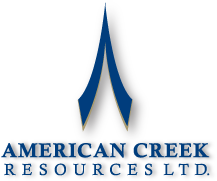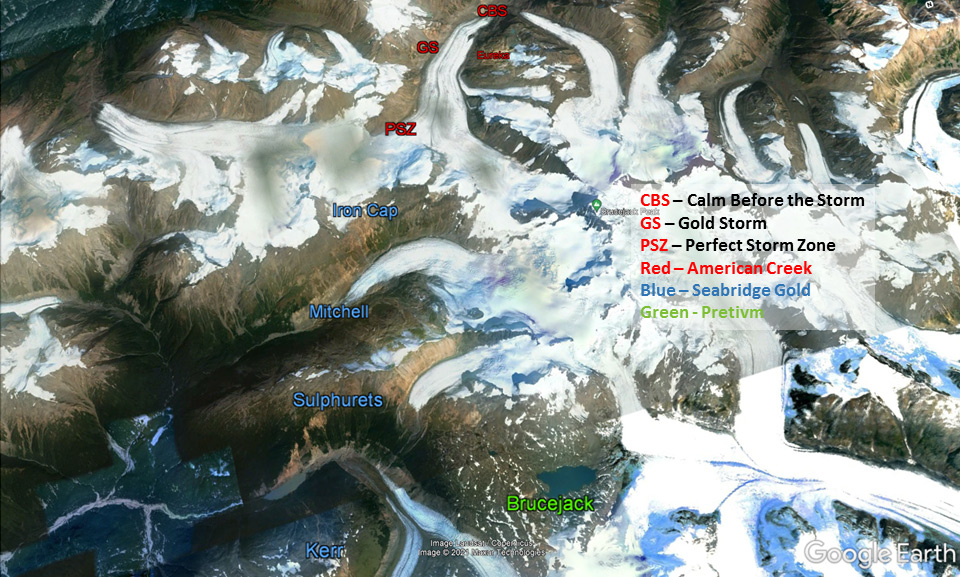Treaty Creek is joint ventured project. Tudor Gold is the operator of the project. American Creek Resources has a 20% fully carried interest in the project until a production notice is given. Therefore, more geological information can be found at Tudor-gold.com.
The Treaty Creek property is located within one of the largest hydrothermal systems in the world. The Sulphurets Hydrothermal System (SHS) contains numerous world scale deposits including Newmont’s high-grade Brucejack mine (opened 2017 by Pretivm) and Seabridge’s KSM project which boasts the largest undeveloped gold deposit (by reserves) in the world, and numerous mineralized zones on Treaty Creek.
The southern half of the system contains 185m oz gold, 740m oz silver, 50bn lbs. copper in resources all categories included. In proven & probable reserves there are over 50m oz gold, 200m oz silver, and 7Bn lbs copper so far.
The northern half of the system covers Treaty Creek and has similar geophysical, geological, and structural signatures to the southern half, but is blessed to be "on the right side of the mountain" and therefore has much better logistics. A mining road and power are within a few short kilometers and bulk tonnage shipping port terminals are just 90 minutes south of the junction with the highway.
The entire Sulphurets Hydrothermal System is connected at depth with strong indications that the north half has similar scale and potential. This projection is backed by a government geological report stating Treaty Creek’s potential to be “B.C.’s next big discovery”. -Kyba 2014.
String of Pearls
Tudor Gold President, Ken Konkin (who was involved in the development of Newmont’s Brucejack Mine just a few kilometers south of Treaty Creek) is an expert in both large scale systems and geology in the Golden Triangle. He has often spoken of the importance of the “frequency for occurrence”, “frequency for distribution”, and “structural traps” of world class hydrothermal systems that create a predictable “rhythm”.
He’s stated that the SHS is a perfect example and refers to its many deposits as a “string of pearls……just really big pearls!” Below is an image showing existing and potential “pearls” in this system
The Kerr, Sulphurets, Mitchell, and Iron Cap deposits are part of the KSM system owned by Seabridge Gold and constitute the largest undeveloped gold deposit in the world by reserves. The Treaty Creek mineral claims boundary is just above the Iron Cap deposit in the image above. The geological sequencing or rhythm of the SHS has produced a district-scale porphyry deposit every 2.5-3km. The Perfectstorm, Goldstorm, and Calm Before the Storm zones are in the perfect and predicted locations to continue the “String of pearls” Konkin spoke of.
Bedrock Geology
The SHS shares a common bedrock geology which primarily consists of the metalliferous Hazelton rock group. When the SHS formed it was a volcanic island arc chain in the Pacific Ocean that was active far longer than other similar systems and therefore richly endowed.
Major Fault
The Sulphurets Thrust Fault that runs throughout the SHS is a major factor in the formation of large porphyry systems along it. Seabridge has stated that it is directly related to the Kerr, Sulphurets, Mitchell I&II, and Iron Cap deposits. It appears that the Sulphurets Thrust Fault continues through the heart of Treaty Creek and is associated with at least the Goldstorm and Perfectstorm zones.
Mineralized Zones
Treaty Creek has a dozen zones of mineralization identified so far. We believe that many of these are surface expressions of a much larger geological system at depth. The current focus is the Goldstorm deposit with initial exploration on the Perfectstorm zone.
Goldstorm
- Is the primary focus of exploration and has a Mineral Resource Estimate (MRE) of 26.54 Million ounces gold, 157.7 million ounces silver, and 3.37 billion pounds of copper.
- Is primarily a gold system with copper and silver gaining strength in the CS (Copper Stream) 600 horizon of the deposit. The CS 600 horizon is growing stronger towards the north east.
- Open in all directions and at depth with geophysics indicating a much larger mineralized area than has been drilled so far. The widest intervals of mineralization are occurring towards the north east.
- While the Goldstorm is classified as a porphyry system with very long intervals of lower-grade gold (very consistent from top to bottom and from hole to hole), it appears that epithermal overprinting has taken place resulting in the discovery of many high-grade veins and elevated gold intervals.
- Enriched 300 horizon starting close to surface and extending 250-350+ metres deep. This covers an extensive area and provides potential for open pit operations (reduced costs).
Perfectstorm
- Has the structural, geological, and geophysical features of the Goldstorm and other deposits in the “string of pearls.”
- Is located “right where it should be” – half way between the Iron Cap deposit (Seabridge) and the Goldstorm deposit (2.5km intervals).
- Is located along the Sulphurets thrust fault and along the “Kyba Line” which is a geological contact where large deposits form.
- Is also located near the Brucejack fault which is responsible for the high-grade Brucejack mine (Newmont) a few kilometers to the south.
- Hosts potential for a large copper, gold, silver porphyry with high-grade epithermal overprinting.
- Geophysics are showing potential to be larger than the Goldstorm zone.
- Initial drilling has confirmed consistent mineralization over broad intervals similar to initial drilling on the Copper Belle / Goldstorm zone.
Calm Before the Storm
- Has the structural, geological, and geophysical features of the Goldstorm and other deposits in the “string of pearls.”
- Is located “right where it should be” – close to 2km further north east of the Goldstorm deposit.
- Is located along the Sulphurets thrust fault.
- Initial drilling has confirmed consistent mineralization over broad intervals similar to initial drilling on the Copper Belle / Goldstorm zone.
Eureka
- Has the structural, geological, and geophysical features of the Goldstorm and other deposits in the “string of pearls.”
- Is potentially related to the Goldstorm – possibly the top half of Goldstorm.
- May be connected to the Goldstorm – further drilling is required.
- Initial drilling has confirmed consistent mineralization over broad intervals similar to initial drilling on the Copper Belle / Goldstorm zone.
BC’s Next Big Deposit
In late 2014, a significant geological report by JoAnne Nelson and Jeff Kyba of the British Columbia Geological Survey, Ministry of Energy and Mines was published and has had a significant impact on exploration in the Golden Triangle. The primary geological focus of it is concerning the contact between the volcanic Hazelton and the sedimentary Stuhini bedrock formations which runs through the SHS. A survey on Treaty Creek was included in the report that sates there are three critical factors in possibly becoming “BC’s next big deposit”. Treaty Creek has all three qualifiers (More).




